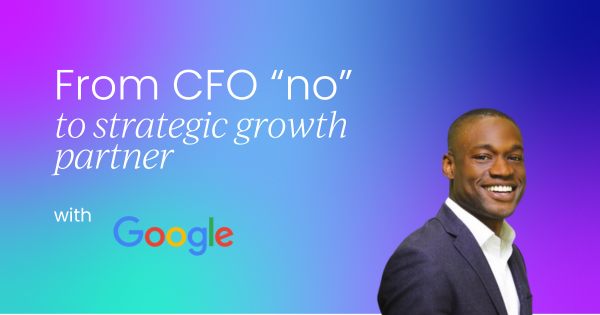Let me share something that might sound familiar.
There's a perception — one I've heard countless times in boardrooms and hallways— that finance is where innovation goes to die. The dreaded "CFO No." But what if I told you that's exactly the perception we need to flip on its head?
I've spent over twenty years scaling organizations, from building the UK's largest telecoms company to helping Google Cloud grow from $12 billion to $48 billion. And here's what I've learned: finance isn't the brake pedal on innovation. It's actually the engine that makes sustainable growth possible.
The evolution from challenger to champion
You know what's interesting? As finance leaders, we've been so good at being challengers — asking "what could go wrong?" and "how do we invest responsibly?" — that we've forgotten the other half of our role. We need to be champions too.
Think about it. When was the last time you asked your business partners, "What gets you excited about this project?" or "How big can this really be?".
These aren't just feel-good questions. They're strategic ones that build trust and credibility.
Here's the thing: to truly influence your company's strategic direction, you need to immerse yourself in the business. Understand the market dynamics. Know the product inside and out. That's how you become a thoughtful strategic partner, not just a gatekeeper.
Balancing growth and risk (without killing innovation)
Now, I'm not saying we should say yes to everything. That would be irresponsible. Our primary role is still balancing growth and risk. But there's a smarter way to do it.
Let me share a real example. When I first joined Google, I was asked to build a business case for insourcing — not outsourcing — thousands of customer support employees. My first reaction? Red flags everywhere. Higher costs, lower flexibility. This seemed crazy.
But instead of shutting it down, I dug deeper. What I discovered changed everything. The complex customer support functions Google manages could actually be handled more efficiently in-house. Better time to resolution meant lower costs. Customer satisfaction would skyrocket. The upfront costs were real, but the long-term benefits were compelling.
So what did we do? We didn't just say yes or no. Instead, we:
- Ran scenario planning and sensitivity analyses
- Implemented a pilot program to test the waters
- Created a staged funding model with clear milestones
- Established go/no-go metrics at each phase
That's how you manage risk while still enabling innovation. You're not closing doors—you're building better frameworks to walk through them.

Making innovation tangible: The Twitter data story
Innovation isn't just about big ideas. It's about turning those ideas into real products and services.
When I was at Twitter, we recognized the massive value in our real-time data. Developers were already using our APIs, but there was no monetization plan.
As the finance team, we saw the opportunity. We built a pricing framework for API licensing and executed M&A transactions to fuel growth. But here's what made it work:
First, we established a capital allocation framework. Everything started with strategy—what's the market potential? What do customers need? What are competitors doing? Then we built financial plans that reflected those inputs, understanding both the long-term revenue potential and the investment required.
And here's something crucial: Today's environment is resource-constrained, meaning it's our job to push for efficiencies so we can invest in high-priority, high-growth areas. It's about being smart with resources, not cutting costs for the sake of it.
Scaling innovation in large organizations
You might think working at Google means unlimited resources and no problems. But large organizations are complex beasts. Sometimes our internal processes can slow us down more than any external factor.
The CFO's role in a large organization is particularly challenging. We introduce processes to reduce risk, which can help or hinder innovation depending on how we implement them. Complex, bureaucratic processes and unclear ownership can kill innovation faster than any budget constraint.
Where I've seen it work, finance acts like an air traffic controller. We understand all the different components of the business, navigate the bureaucratic processes, and pull everything together. We lead with data-driven decision making, always asking "what," "so what," and "what next?"
Take data center buildouts, for example. They typically take five years to show returns. Finance teams that succeed here assess market growth, understand customer perspectives, and use financial analysis to provide clear recommendations. They set KPIs upfront and stick to them because changing metrics mid-project frustrates everyone and kills trust.
Communicating innovation value to investors and boards
Here's the tough part: explaining innovation to those holding the purse strings.
I've found three approaches that work:
Strategic Alignment
Every innovation project needs to tie directly to your company's strategic objectives. When we built an object storage business at Hitachi, we evaluated fifty to sixty potential projects. Each one was assessed against clear criteria: ARR contribution, market expansion potential, customer stickiness. The winners aligned with our international expansion goals.
Compelling Narratives
Data alone isn't enough. In moments of uncertainty, emotion becomes a powerful tool. Tell a story your board can journey with. If it's an acquisition, how does it fill product gaps? Open new markets? Change your competitive position? Use visual aids. Make it real.
Scenario Planning
Show you've thought through multiple futures. What happens if a competitor launches six months before you? If your co-creation customer changes direction? Present a range of scenarios with action plans for each. Decision makers are more comfortable with calculated risks when they see you've considered what could go wrong and have mitigation plans ready.
Building an innovative finance team
Organizations are made of people. If you want an innovative finance function, you need innovative finance people. But here's something interesting—my strategic finance team? Many don't have traditional finance backgrounds.
What I look for is curiosity. I can teach modeling. I can coach financial analysis. But I can't teach someone to ask those five, six, seven questions that get to the right answer. I need people who wake up excited to figure things out, who aren't satisfied until they understand the unit economics of every component.
Passion matters too. Innovation, especially when it involves new, unproven ideas, is hard to execute. People will tell you no. You need team members with the tenacity to drive things forward and bring others along.
The path forward
We're in an interesting economic cycle. We've moved from growth at all costs to sustainable, efficient growth. This is actually an opportunity for finance to shine. We can help our organizations innovate smarter, not just faster.
The key is being proactive. Build processes that scale with your business. Understand how innovation projects impact both business operations and finance processes. Don't wait until the CEO starts asking strategic questions to other teams because finance couldn't keep up.
Remember, finance has the power to influence your company's strategic direction. But only if we evolve from being just challengers to being champions too. Only if we balance our natural risk management instincts with genuine curiosity about what's possible.
So next time someone comes to you with an innovative idea, don't start with "no." Start with "tell me more." Ask what excites them. Understand the potential. Then use your financial expertise to find the smartest path forward.
That's how we change the perception. That's how we become true strategic partners in innovation. And that's how finance drives the sustainable growth our organizations need to thrive.
What innovation opportunity is sitting on your desk right now, waiting for a champion?
This article is based on Kevwe's appearance at the Chief Finance Officer Summit, San Jose (2025). Pro+ members can watch the talk in full right here.



 Follow us on LinkedIn
Follow us on LinkedIn




